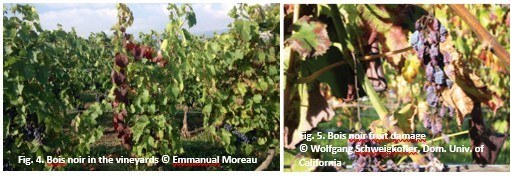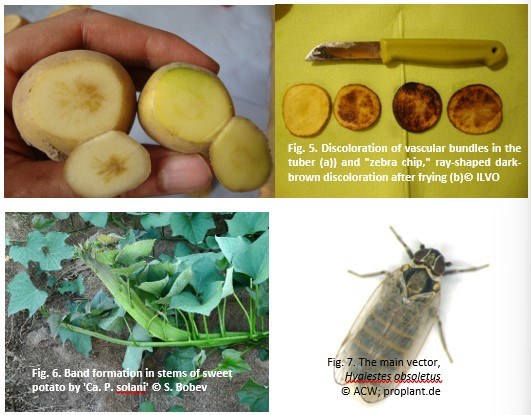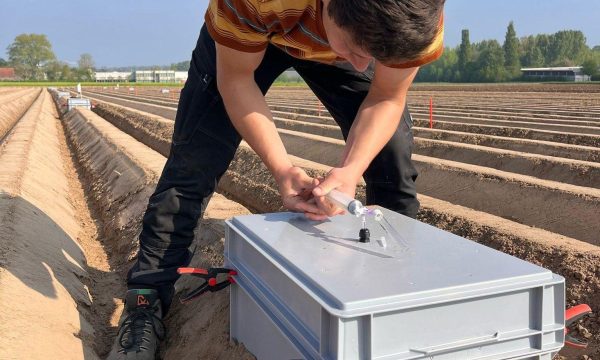General Plant pest(s): ‘Candidatus Phytoplasma solani’
The pathogen 'Candidatus Phytoplasma solani' is a small cell wall-less bacterium. A phytoplasma, therefore, more specifically of the class Mollicutes. This organism develops both in the plant phloem (this is the hard tissue of the stem or stalk) and in its insect vector. The term ‘Candidatus’ is used to refer to a group of bacteria that cannot be isolated. The bacterium is capable of infecting a very wide range of host plants, including some important cultivated crops such as potato, bell pepper, tomato, sugar beet, corn and strawberry. Numerous weeds can also become infected and act as reservoir plants.
How do you recognize an infected plant?
The pictures below show that the symptoms that appear on plants as a result of an infestation can be very diverse:
- discoloration of leaves (yellow, red, purple) (Figs. 3 & 4)
- discoloration in tubers (Fig. 6a,b)
- Leaf and stem deformities (Figs. 1, 2, 3, 6)
- growth retardation (Figs. 2, 3)
- crop losses due to fruit shriveling, among other things (Fig. 5).
Major diseases and related major economic losses caused by this bacterium are "basses richesses" in sugar beet, "maize redness" in corn, "zebra chip" in potato, "bois noir" in grape in vineyards and "stolbur" in lavender. This last name, "stolbur," is also a very commonly used term to refer to this pathogen in various host plants.


Does this constitute a major risk in Flanders?
Depending on the host plant and the region (climate), the phytosanitary risks may nevertheless be high. This is linked to the wide host plant range of this pathogen and the widespread occurrence of its vectors (cicadae; Hyalestes obsoletus (Fig. 7.), Reptalus panzeri, Anaceratagallia ribauti). In our region, and by extension throughout Europe, it is mainly the polyphagous, endemic and widespread H. obsoletus that provides the spread of this phloem-associated bacterium. However, all previously listed economically important host plants are so-called dead-end host plants because the vector (the cicada) does not fully complete its life cycle on these crops.

Thus, the risk of acquiring an infestation of epidemic proportions is rather limited and we therefore see mainly accidental outbreaks by spread from one host plant to another via feeding adults. Only lavender and a few important weed crops such as field bindweed and nettles act as full-fledged host plant reservoirs for both 'Ca. P. solani' and the vector. Transmission via tubers (e.g. in the few foci already established in potato in our country) is also very limited. A risk analysis document by Fera (UK) reported a transmission rate of only 0.5% to daughter tubers.
What can we do about it?
Control of 'Ca. P solani' foci in the field is difficult. Control of the pathogen is limited to destruction of affected plants, and vector control options are also limited, especially in the absence of suitable natural enemies. Orius predatory bugs and Chrysopa larvae are predators, but rather prefer other prey when available. Nevertheless, attention to indirect control through efficient management of the above natural reservoir weeds is certainly important.
The identified significant phytosanitary risks led to regulation of this organism in the EU. 'Ca. P. solani' is on the EPPO A2 list, and is included in the plant health legislation (EU 2019/2072) on the RNQP (regulated non quarantine pathogens) list for grape, strawberry, blueberry, potato and for plant and propagation materials. Fiches of these RNQP organisms are available on the Department of Agriculture and Fisheries website with more information on their biological properties, distribution and symptoms.
There are also two ongoing research projects (PHYLIB III and METAMINSURV), the first on epidemiological aspects of phytoplasma and 'Ca Liberibacter' diseases in potato and the second on innovative detection of phytoplasma pathogens via nanopore sequencing. There is also a project on yellowing viruses in sugar beet (VIRBICON), where it is possible that 'basses richesses' may also be detected.


